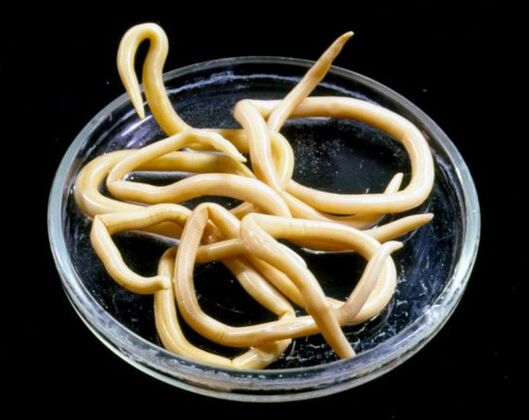The most common helminths are human worms. These parasites in the human body lead to many complications, including: violations of the gastrointestinal tract, bodily damage to internal organs, helminths.
Helminthiasis is not a disease but a group of diseases caused by parasites that live inside the human body. All helminths are divided into 3 main categories:
- nematodes (belonging to the order nematodes), prominent representatives - nematodes, pinworms, whipworms;
- tapeworms, or tapeworms (a group of flatworms), represented by tapeworms, bovine tapeworms;
- flukes or flukes (part of flatworms) are represented by liver flukes.
Because helminths leave the host during the breeding season to preserve the species, when transferred to an vector or other environment, they are also divided according to the mode of transmission:
- Mechanical transfer involves long-distance travel, while the development of worms in the body of the carrier does not occur. These include most of the arthropods (crustaceans, arachnids and centipedes) normally carried on the legs of common flies.
- An intermediate host is a special mode of transfer in which one of the developmental stages occurs within the host organism. For example, for bovine tapeworms, pets act as carriers (intermediate hosts) and humans as final carriers.
The helminths differ according to the method of transmission:
- activities (contact);
- passive (food).
Contact worms can enter the human body through mucous membranes and skin (schistosomes, hookworms). Food products are more common, they develop in a person after eating unwashed food, contact with a sick person or failure to observe the rules of personal hygiene.
In total, there are more than 250 types of lower worms that parasitize humans in the world. Since the symptoms of the presence of worms in humans vary, therefore, when there is little doubt, you should see a specialist and conduct an examination.
The life cycle of worms, their reproduction and development
An example of helminth development is the classical diagram of the life cycle of nematodes. The eggs of the parasite are extremely resistant to adverse external influences and can survive in the soil for up to six months.
Larval development takes from 2 weeks to 2 months, depending on environmental conditions: temperature, humidity, oxygen availability. A mature egg with food enters the stomach, where gastric juices eat away at the shell, releasing the larvae.

The nematodes then enter the bloodstream through the intestinal wall and begin to migrate throughout the vascular system until entering the pulmonary alveoli. The nematode larva is aerobic, only here it becomes active and continues to develop.
Bloodsucking, it grows up to 3-4 mm in length. After primary maturation 4-5 days after invasion, the nematodes begin to migrate into the bronchi.
Its movement causes coughing in a person, as a result of which the larvae, along with mucus, enter the oral cavity and return to the intestines. Here takes place the final stage of larval formation in adults.
The life cycle of an adult roundworm lasts about a year, during which time it lays up to 250, 000 eggs. Human health, and sometimes life, depends directly on the presence of worms in the body and their numbers, so it is important to start treatment as soon as possible.
Roundworm accompanied by intoxication and intestinal obstruction will be a complication, which in some cases will require urgent surgical intervention.
Reproduction of helminths occurs in 2 ways, in which helminths are divided into biotic helminths and biotic helminths. Usually, the eggs of the parasites enter the external environment - here they mature. The egg must then enter the host, where it fully develops (earthworms) or undergoes a larval stage (biological worms).

In biological worms, the development process is more complex, with the development stages in an adult individual and the adult stage separate from the stage of larval emergence. That is, from the external environment, the eggs first enter the intermediate carrier, where the larvae hatch.
Therefore, he needs to enter the final host's body in order to attain his adult form. Sometimes biological worms change up to 4 intermediate carriers before reaching the final host.
Symptom
How to determine the presence of worms? The polymorphic and painless symptoms in the early stages of the disease make diagnosis difficult.
Usually, the cause of the appearance of worms in humans is related to the use of rancid or contaminated food, and the parasites themselves live directly in the digestive tract, so signs oftheir presence in the human body is in most cases related to the functioning of the intestines:
- loose stools (unstable;
- pain and swelling;
- allergic skin rash;
- flatulence;
- nausea;
- he vomited;
- lack or excess appetite;
- at night - sleep disturbances, throwing, teeth grinding, salivation;
- itching in the anus;
- the presence of mucus or blood in the stool.
These symptoms appear after infection and are short-lived (about 7 days). In the case of re-invasion, they are repeated after 2-3 weeks.
In the absence of treatment or due to the appearance of an acute or chronic form of the disease, some symptoms do not go away, the consequences of a long survival of the parasite in the body are added:
- Intoxication appears almost simultaneously with the infection, but in the early stages it is not so noticeable. The more worms in a person, the more symptoms of poisoning, from morning sickness to vomiting and abdominal pain.
- Obstruction in the lungs (infiltrates), bronchospasm, pneumonia. The main culprit is parasites that grow in the alveoli of the lungs and damage them, causing inflammation.
- Myocarditis (inflammation of the heart muscle). Infectious disease, the result of significant helminthic activity and subsequent intoxication.
- Meningococcal meningitis is a dangerous inflammation of the brain and meninges caused by bacteria and protozoa.
Different pathogens have their own manifestations and consequences, but most of the symptoms are common to all helminths.
diagnose
Diagnosis is made in the laboratory. Only in this case, when worm eggs and their signs are present in the blood or stool, can helminthiasis be diagnosed with certainty. However, stool analysis is not always enough: some types of parasites do not manifest in them.
A special method for determining the presence of worms is a serological test for antibodies. For the diagnosis of helminthiasis are used:
- secret research;
- macroscopic examination (to detect roundworms and pinworms);
- muscle tissue biopsy when checking for trichiasis;
- x-ray and ultrasound.
Trichinosis is a parasitic disease in which the larvae of the pathogen spread throughout the body of the carrier, causing extensive damage to the organs and central nervous system, after which they settle in muscle tissue.
Parasites in a person's muscles gradually create an infiltrate around themselves, and the symptoms of their presence in the body subside, but by this time the health of the owner has been seriously compromised. important.

One of the main symptoms can be considered eosinophilia, in which the number of eosinophils in the patient's blood increases significantly. Eosinophils are a subspecies of white blood cells that respond to the presence of small foreign bodies in the circulatory system.
In places of accumulation of larvae of parasites, internal swelling and spots on the skin quickly appear - traces of penetration. They also exist in sputum and lung fluid.
Because the symptoms of helminthiasis are so extensive and largely overlap with the signs of other diseases, self-diagnosis cannot be completely reliable.
There are cases that after eating bananas, people notice that there are dark threads in the stool, so worms should be taken. Before starting treatment, it is necessary to pass all tests for the presence and type of parasites.
Treatment of helminths
During the treatment of parasitic diseases, a number of general rules must be observed:
- Thoroughly disinfect the sick linen and the room in which it is located. Keeping the points of contact to a minimum, the plates should be separated.
- Strict non-alcoholic diet. It is recommended to use an infusion of carrot juice and birch sprouts.
- Personal hygiene, frequent hand washing and laundry, cleaning of premises.
- Monitor the course of treatment and its effectiveness.
Modern methods of treatment exclude the use of a separate drug, since this does not guarantee complete coverage of all helminths. Usually, the doctor prescribes a medication that initially weakens the parasite.
If it is not possible to consult a doctor, folk remedies are used. A good anthelmintic effect is achieved by:
- garlic infusion enema, take garlic on an empty stomach;
- tansy infusion on an empty stomach 4 times a day before meals;
- tincture of wormwood on alcohol, take 20 mg 3 times a day.
Human worms in our time are diagnosed and treated in a short time. If you do not initiate the disease and start treatment in time, this will help avoid complications and re-invasion.
The greatest danger of parasitic diseases is for children: mental retardation, complications arising in the form of chronic diseases, inflammatory processes.
It is extremely important to promptly explain to the child the need to wash hands and observe the rules of personal hygiene. At the same time, adults are asked to observe other precautions.
Prevention of helminths
In addition to personal hygiene, there are several factors that affect the elimination of the cause of worms:
- wash vegetables with hot water;
- keep the house clean, regularly conduct wet cleaning;
- a balanced diet that provides the body with adequate amounts of vitamins of all groups;
- monitor the condition of the pet, visit the veterinarian every year;
- full heat treatment of fish and meat;
- against insects living in the house;
- Limit bathing and resting in livestock grazing areas.
Adhering to preventive measures and promptly contacting a doctor in the event of an infection will help avoid complications. Using the right dose of medicine prescribed by a specialist will quickly eliminate parasites, it is possible to use folk remedies in combination with prescription drugs.






































